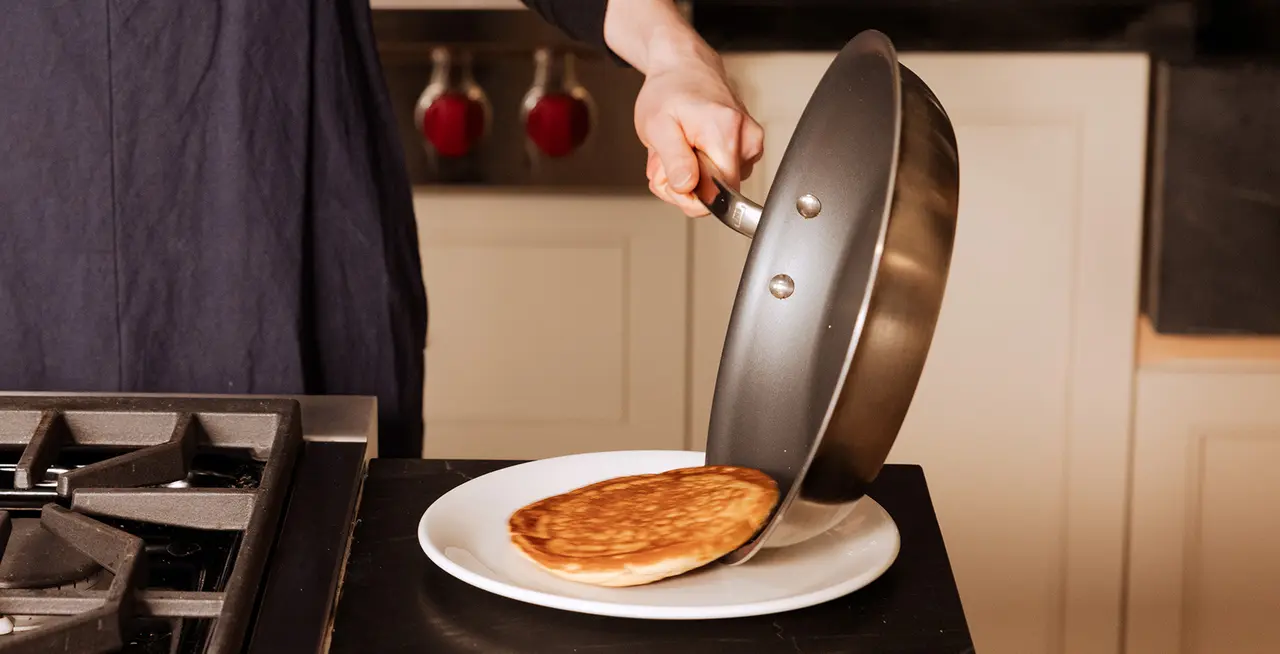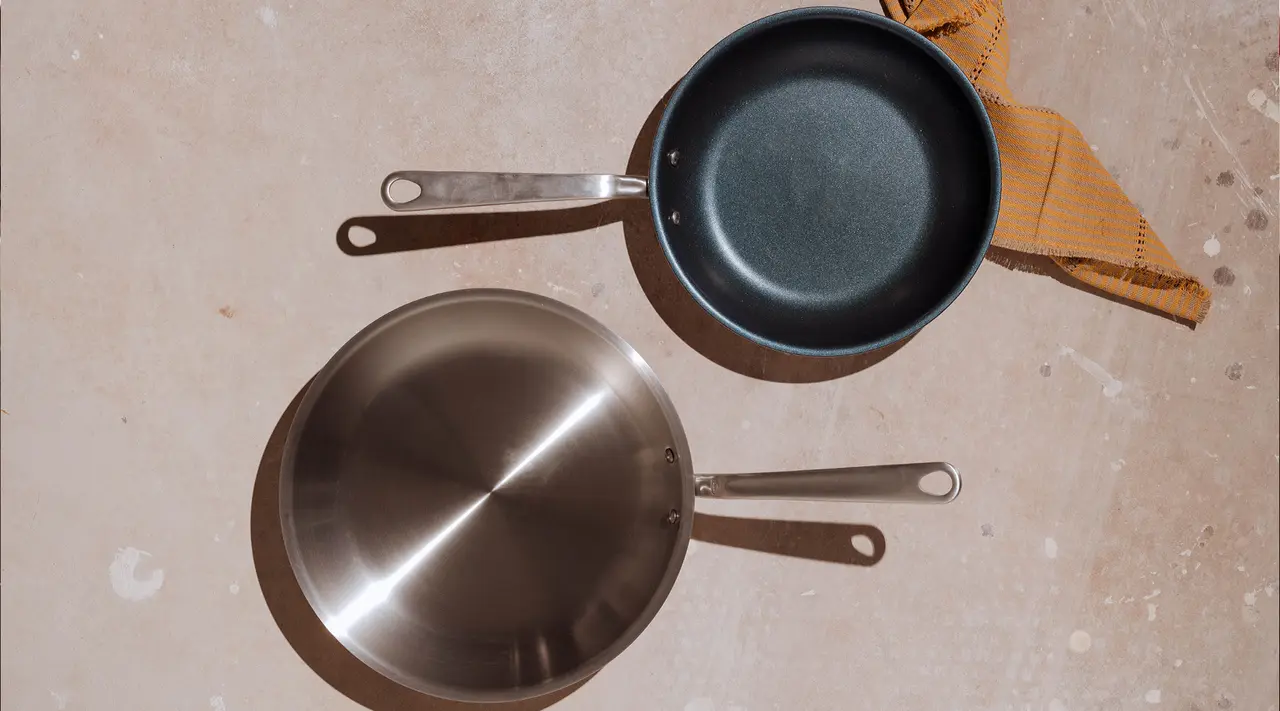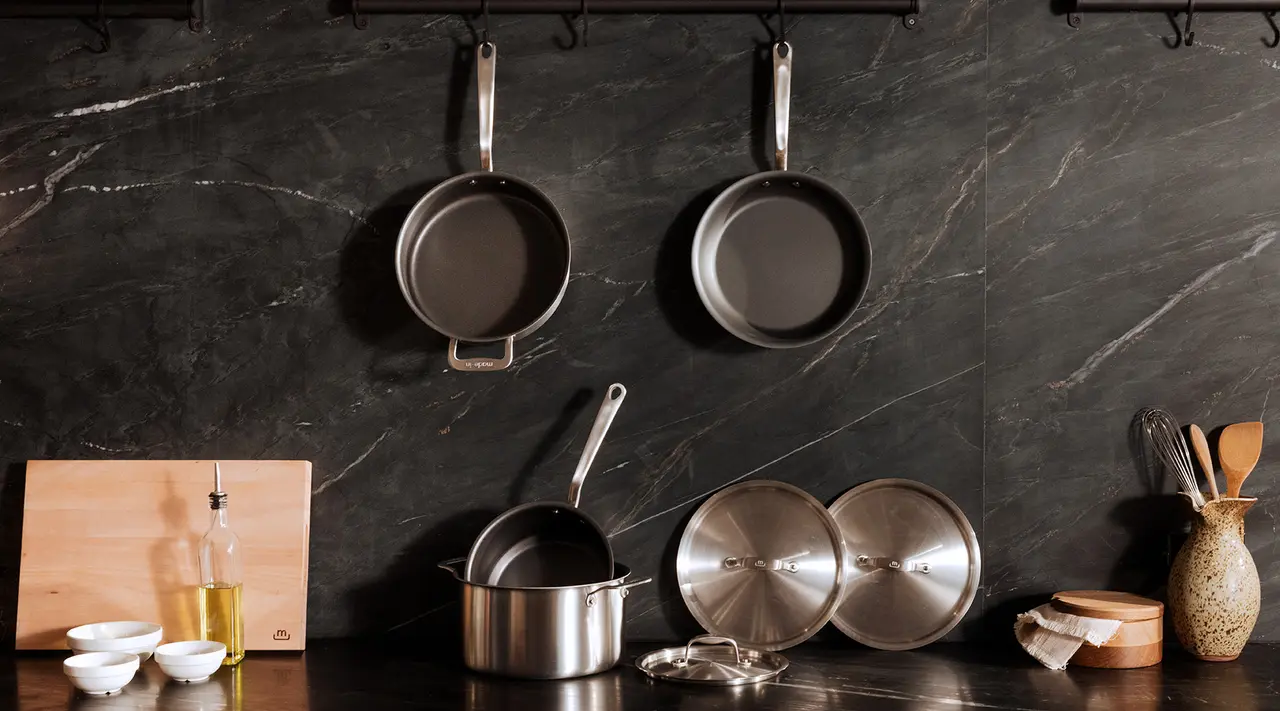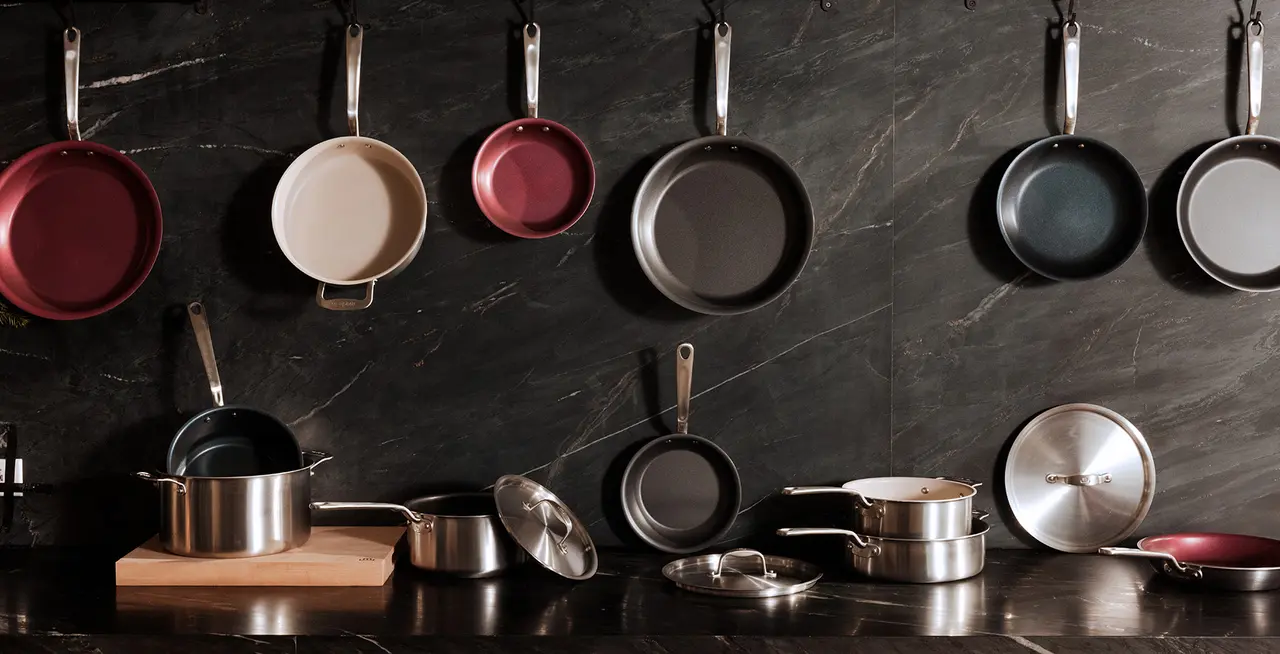If you were to open the cabinets in any kitchen, odds are you’d find a piece of non stick cookware. This popular material is lightweight, versatile, easy to use, and available at a range of price points, making it accessible for anyone from a college student to a professional chef.
If you’re looking to upgrade your existing non stick or are adding it to your kitchen for the first time, there are a few things to keep in mind while shopping.
What Is Non Stick Cookware?

Non stick cookware’s defining feature is its convenient, easy to clean, and frictionless cooking surface that prevents almost any ingredient from sticking, be it flaky fish or fluffy eggs.
The most popular shape of non stick cookware is the skillet or frying pan—the obvious essential in any kitchen. However, non stick comes in many different shapes and sizes, from saucepans to stock pots, all of which are excellent, stick-free additions to any cookware collection.
How Is it Made?
Though the construction methods and materials used to make non stick cookware will differ from manufacturer to manufacturer, these pans are generally made by applying layers of a non stick coating to a metal base (usually aluminum, stainless steel, or a combination). Typically, the more layers of non stick coating that are applied, the longer the coating will last—though this also depends on how high-quality the coating itself is.
The construction of the metal base matters just as much as the coating itself, as this is what will dictate even heat distribution and control while you're cooking. Read more about why workhorse construction and design matters when it comes to non stick.
How Long Will it Stay Non Stick?
Non stick cookware does not last forever, but high-quality construction materials, multiple layers of non stick coating, and proper maintenance and care will dramatically prolong its life span.
This means that a pan used with non stick-friendly utensils that isw properly cleaned and stored properly after each use will have a much longer lifespan that one that continually had metal utensils used on it, food stored in it, and was cleaned in the dishwasher.
Non stick pans may not boast the same lifespan of stainless steel or cast iron, but non stick cookware isn’t—and shouldn’t be treated like as—disposable. Especially if you treat your cookware with care, you can extend the life of it for many years.
Is It Oven Safe?
Having oven-safe non stick cookware means dishes like Dutch babies are achievable in your favorite non stick pan, not to mention unlocks the ability to oven-finish your meals. But finding oven-safe non stick is often easier said than done, and generally you’ll be limited to higher-end options. If any part of the cookware is plastic, nylon, or silicone (like the handles), then it’s not safe to put in the oven.
If having an oven-safe non stick pan is important to you, then you’ll want to make sure the handles and body are composed of entirely oven-safe materials, like stainless steel. You can also check out our guide on if (and when) non stick can go in the oven.
Oven-safe non stick cookware are generally higher-quality than their non oven-safe counterparts, due to the construction materials necessary to keep non stick safe to high temperatures. Our ProCoat Non Stick Collection is oven-safe up to 500F, meaning it's safe for everything but broiling.
Note that non stick coating wears away faster when continually exposed to high temperatures. Though our ProCoat Non Stick is oven-safe up to 500F, it should rarely need to be used at that high of a temperature.
How Do You Care for Non Stick Cookware?
Non stick is some of the easiest cookware to clean and maintain, and will last for years with proper care.
For everyday cleanup, its non stick surface can easily be wiped clean with water, soap, and a non-abrasive cloth or sponge (we recommend avoiding the dishwasher, as this will quickly cause the coating to wear out). Tougher burnt on residue is quickly removed by simmering water in the pan until stuck-on food is released.
Our guide on how to clean non stick cookware has more details on step-by-step cleaning instructions, as well as how to get off even the toughest grease or oil stains.
How Does it Compare to Other Cookware Materials?

Non stick cookware has easily earned its place in the kitchen, but it’s important to know how it fits into your already existing collection. To help you see what gaps it can help fill, here’s how non stick compares to other popular cookware materials.
Non Stick vs. Carbon Steel
Carbon steel cookware is an increasingly popular choice for both home and professional chefs. In terms of performance, it combines the best parts of stainless steel and cast iron cookware.
The only similarity carbon steel and non stick cookware share is their non stick surface, and even that is different in how it’s achieved. The cooking surface of non stick is non stick straight out of the box, while the surface of carbon steel is built up with layers of seasoning. They’re akin to ships passing in the night—where non stick starts strong and slowly fades over several years, carbon steel needs coaxing to develop its non stick surface but will last for as long as you maintain its seasoning.
Once fully seasoned, carbon steel can handle the same sort of delicate ingredients that non stick can, but shouldn’t be used with acidic ingredients like tomatoes or lemons—since carbon steel is considered reactive, these ingredients can degrade the seasoning and are better used in a non-reactive pan (like non stick).
Think of these materials not as an either-or choice, but as building blocks of a fully stocked cookware collection. See more about the differences and similarities between the two in our guide to non stick vs. carbon steel.
Non Stick vs. Cast Iron
Whether bought new or passed down as an heirloom, the cast iron skillet is a cookware staple. Made of either enameled or unfinished pure cast iron, these pans can be used for anything from simmering to searing. Both non stick and enameled cast iron cookware have no-stick, coated surfaces, but unfinished cast iron is similar to carbon steel in its need for seasoning.
The main differences between non stick and cast iron lies in their weight, maintenance, and lifespans.
- Weight: Due to its construction materials, non stick is much lighter than cast iron and some may find it easier to wield.
- Maintenance: Unfinished cast iron requires special maintenance and seasoning in order to develop and prolong its non stick capabilities, while non stick is much less demanding—note that enameled cast iron is just as easy to care for as non stick thanks to its enameled coating.
- Lifespan: Even the most high-quality non stick pan will eventually lose its coating and need to be replaced—premium pans will buy you more time and better results. When cared for properly, both unfinished and enameled cast iron can last for multiple generations, hence its reputation as a heirloom piece.
Non stick and cast iron skillets have their similarities and differences, so we recommend having both in your collection. They both have their place in the kitchen, and fill gaps each other leaves in terms of use.
Non Stick vs. Ceramic
Unlike its name implies, ceramic cookware is not made of an actual ceramic material (like stoneware or kiln-fired pottery). Instead, it’s a type of non stick composed of a naturally-derived coating applied over a metal base (very similarly to the process of creating non stick).
These two pans are the most similar of any on this list, and for that reason we'll point you to our guide on how non stick compares to ceramic cookware for a more in-depth comparison.
Non Stick vs. Stainless Steel
Of all the comparisons to make between non stick cookware and another material, stainless steel is the least similar one. Known for its tendency to stick, stainless steel cookware is uncoated and hyper durable, making it an ideal surface for high-heat cooking and searing, while non stick is perfect for lower-heat cooking and more delicate ingredients.
This is just part of why, similar to carbon steel cookware, non stick and stainless steel should be treated as complements and not competitors in a cookware collection. Read our comparison guide on non stick vs. stainless steel for more reasons why this shouldn’t be treated as an either-or decision.
How Much Is Non Stick Cookware?

Depending on factors like which materials are used to manufacture it, a set of non stick cookware can range from relatively inexpensive (less than $100) to quite expensive (over $1,000). It will generally be more affordable for individual pieces of non stick, such as one non stick pan, but it can be worthwhile to invest in a cookware set if you need to outfit or overhaul an entire kitchen.
In the long run, it will ultimately be cheaper to invest in high-quality non stick pans than buying inexpensive non stick that will need to be replaced often.
Our Recommended Non Stick Pans
You likely knew that it was helpful to have at least one piece of non stick cookware in your kitchen arsenal—but hopefully, now you understand why it’s an absolute staple in your cookware rotation.
If you’re ready to add or expand upon your non stick collection, look no further than our line of chef-loved ProCoat Non Stick Cookware. Award-Winning, 5-Ply Stainless Clad is topped with multiple layers of professional-grade Non Stick coating that results in an oven-safe, incredibly durable, high-performing tool that makes an excellent addition to any kitchen.
Trusted by chefs and and with over 100,000 5-star reviews, you know you'll be getting the best there is.
























